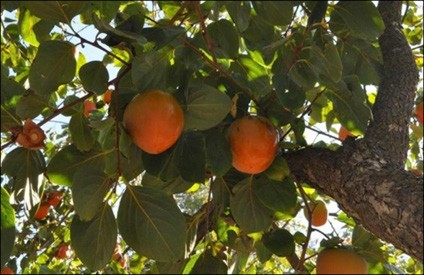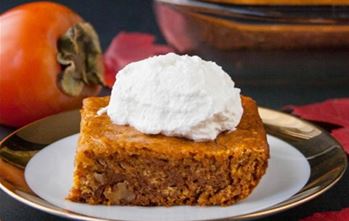AgEBB-MU CAFNR Extension
Green Horizons
Volume 21, Number 3
Fall 2017
Agroforestry
Species Spotlight: Persimmon
By Hank Stelzer| MU Extension - School of Natural Resources
Persimmon (Diospyros virginiana) goes by many common names; American persimmon, common persimmon, eastern persimmon, "simmon", "possumwood", even "sugar-plum". It ranges from southern Connecticut/Long Island to Florida, and west to Texas, Louisiana, Oklahoma, Kansas, and Iowa.
On the local landscape, its range is just as variable; occurring in rocky, dry, open woods; edges of woods, glades, prairies and wetlands, old fields, fencerows, bottomland woods and along streams.
It is a medium-sized tree usually 30 through 80 feet in height, with a short, slender trunk and spreading, often pendulous branches, which form a broad or narrow, round-topped canopy.
The peculiar astringency of the fruit is due to the presence of a tannin similar to that of Cinchona. A common joke among people in the know is to induce strangers to taste unripe persimmon fruit, as its very astringent bitterness is shocking to those unfamiliar with it.
 |
Persimmons are round, juicy berries, pale orange in color with a slight waxy bloom, ripening in late autumn. |
Persimmon Pudding.
This is a baked dessert with the taste of pumpkin and the texture of gingerbread. (Yum!). The recipe is from the "Indiana Nut Growers Cookbook" (1995), courtesy of the Indiana Nutgrowers Association.
Ingredients:
2 Cups persimmon pulp
2 Cups sugar
3 small eggs
1/2 stick (4 Tablespoons) margarine
1 teaspoon baking soda
1/2 Cup buttermilk
1-3/4 Cups sweet cream (or milk)
1 teaspoon cinnamon
2 Tablespoons additional persimmon pulp
1-3/4 Cups flour
1 teaspoon baking powder
 |
Serve with a dollop of whipped cream and enjoy |
Instructions:
Mix together the persimmon pulp, sugar and eggs.
Mix baking soda with buttermilk and add to mixture in bowl.
Melt margarine in baking pan and add to mixture.
Sift flour and baking powder together and add alter- nately with cream or milk. Add cinnamon and mix well.
Fold in the additional 2 Tablespoons persimmon pulp.
Pour into 13 x 9-inch metal pan and bake at 350 °F for 55-60 minutes. Be careful not to over bake.
And many folk use the seed to predict upcoming winter weather. Taking a ripe seed from a locally- grown tree, they carefully cut it open and observe the kernel inside. If the kernel is spoon-shaped, lots of heavy, wet snow will fall. Spoon = shovel! If it is fork- shaped, you can expect powdery, light snow and a mild winter. If the kernel is knife-shaped, expect to be "cut" by icy, cutting winds.
Leaves: Alternate, simple, four to six inches long, one to three inches wide, broadest above the middle. Leaf margins are smooth. Mature leaves are thick, dark green, shining above, pale and often pubescent beneath. In autumn, they sometimes turn orange or scarlet, but they can also fall without changing color. A tea can be made from the leaves.
Flowers: Fragrant male and female flowers are green- ish-yellow to cream white and borne on separate trees in May/June, when leaves are half-grown. The flowers are pollinated by insects and wind. Fruiting typically begins when the tree is about six years old.
Fruit: A juicy berry about one inch in diameter, con- taining one to eight seeds. It ripens in late autumn, is pale orange with a red cheek, often covered with a slight glaucous bloom. The seeds can be roasted and used as a coffee substitute, and during the American Civil War they were used as buttons.
Its flesh is astringent while green, sweet and luscious when ripe. The fruit is high in Vitamin C. The fruit pulp can be used to make molasses or fermented with hops, cornmeal or wheat bran into a beer of sorts or made into brandy. Other popular uses include des- serts such as persimmon pie, persimmon pudding, or persimmon candy.
Bark: Dark brown or dark gray, deeply divided into plates whose surface is scaly.
Twigs and winter buds: Twigs are slender, zigzag, varying in color from light brown to ashy gray and finally become reddish brown. Astringent and bitter. Buds are ovate, acute, one-eighth of an inch long, cov- ered with thick reddish or purple scales.
Wood: Yellowish white sapwood; heavy, hard, strong and very close grained. The small amount of heart- wood is a true ebony ranging in color from blackish brown to black, often streaked, and irregular in outline. One cubic foot weighs 49.28 pounds. It is difficult to season, difficult to work with tools, but fairly stable when dry. When subject to wear, it polishes to a very smooth surface. The wood has been used for golf club heads and shuttles in the textile industry.
Folklore: People think that frost is required to make the fruit edible. But, fully ripened fruit lightly shaken from the tree or found on the ground below the tree is sweet, juicy and delicious.
